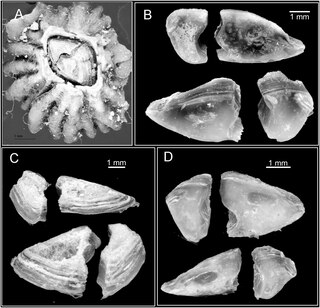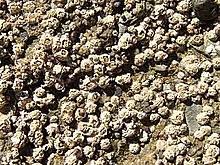
Thoracica is an infraclass of crustaceans which contains the most familiar species of barnacles found on rocky coasts, such as Semibalanus balanoides and Chthamalus stellatus. They have six well-developed limbs, and may be either stalked or sessile. The carapace is heavily calcified. The group includes free-living and commensal species.

Nematanthus is a genus of flowering plants in the family Gesneriaceae. All of its species are endemic to Brazil. Compared to other gesneriads, Nematanthus has leaves that are small, succulent, and hard-surfaced. The plant has a trailing, branching, and spreading habit; it is generally an epiphyte in nature and a hanging-basket plant in cultivation. The flower has fused petals. In some species, the flower has a "pouch" at the bottom. The fancied resemblance of such flowers to a goldfish gives these plants the common name goldfish plant or guppy plant.

The Chthamalidae are a family of chthamaloid barnacles, living entirely in intertidal/subtidal habitats, characterized by a primary shell wall of eight, six, or four plates, lacking imbricating plate whorls, and either membraneous or more rarely calcareous basis. They are not found below immediate subtidal habitats, and more likely are found in the highest tier of shallow-water barnacle fauna. They can be found in the most rigorous wave-washed locations, and some species are found in the surf zone above high tide mark, only receiving water from wave action at high tide.

Acorn barnacle and acorn shell are vernacular names for certain types of stalkless barnacles, generally excluding stalked or gooseneck barnacles. As adults they are typically cone-shaped, symmetrical, and attached to rocks or other fixed objects in the ocean. Members of the barnacle order Balanomorpha are often called acorn barnacles.

Chthamalus is a genus of barnacles that is found along almost all non-boreal coasts of the northern hemisphere, as well as many regions in the southern hemisphere. These small barnacles have been studied in part because of the taxonomic confusion over a group of species that, by and large, are morphologically and ecologically quite similar. In recent years, molecular techniques have identified a number of cryptic species that have been subsequently confirmed by taxonomists using morphological measurements. Most recently the genus has been shown to be paraphyletic, with the genus Microeuraphia nested within Chthamalus.

Chthamalus stellatus, common name Poli's stellate barnacle, is a species of acorn barnacle common on rocky shores in South West England, Ireland, and Southern Europe. It is named after Giuseppe Saverio Poli.

Chthamalus montagui, common name Montagu's stellate barnacle, is a species of acorn barnacle common on rocky shores in South West England, Ireland, and Southern Europe.
Hemioniscus balani, a species of isopod crustacean, is a widespread parasitic castrator of barnacle in the northern Atlantic Ocean. Its range extends from Norway to the Atlantic coast of France, and as far west as Massachusetts. It is also commonly found on the Pacific coast of North America; it is not known if the Pacific and Atlantic populations are the same species, or if the Pacific population exists following human-assisted introduction.

Notochthamalus scabrosus, the only species in the genus Notochthamalus, is a species of barnacle found along the south-western and south-eastern coasts of South America, from Peru to the Falkland Islands. The species is found almost exclusively higher in the intertidal zone than the mussel Perumytilus, often codistributed with the confamilial barnacle Jehlius cirratus and Balanus flosculus.

The Peronopsidae comprise the earliest family of the Agnostina suborder. Species of this family occurred on all paleocontinents. The earliest representatives of this family first occur just before the start of the Middle Cambrian, and the last disappeared just after the start of the Upper Cambrian.

Chthamalus anisopoma is a species of intertidal barnacle. Indigenous to the northern Gulf of California, adult Chthamalus anisopoma are found on exposed shores between 0.0 and 2.0 m above mean low tide. The species is typically absent in areas protected from wave splash. Notably, Chthamalus anisipoma exhibits predator-mediated plasticity in the growth of its calcareous test. In the presence of the carnivorous gastropod Acanthina angelica, the barnacle's typical conical growth form is altered to appear bent over, with the operculum perpendicular to the substrate. The alternate form is more resistant to predation.

Chthamalus fragilis is a small gray barnacle found in the upper intertidal zone of the northwestern Atlantic Ocean, from approximately Cape Cod southward to Florida and into the Caribbean and Gulf of Mexico. It is also commonly known as little grey barnacle. The species is believed to have been distributed only as far northward as North Carolina or Virginia until the late 1800s, when it was noticed along the Massachusetts coast. The species may have expanded its range naturally or been introduced to New England through anthropogenic activities. Chthamalus fragilis is unusual in that it often recruits to stems of Spartina alterniflora.

Chthamalus antennatus, the six-plated barnacle is a species of intertidal barnacle found in eastern and southern Australia. Growing from two centimetres wide and one centimetre high. The barnacle is found on the coast, usually on rocks at or above the high tide level or just below the splash zone. Feeding occurs only at unusually high tides.

Chthamalus dalli, commonly known as the little brown barnacle, is a species of barnacle in the family Chthamalidae. It can be found in intertidal zones along the North American Pacific coast from Alaska to San Diego.

Chthamalus dentatus, the tooth barnacle, is a species of star barnacle in the family Chthamalidae.

Chthamalus malayensis is a species of star barnacle in the family Chthamalidae.

Chthamalus hedgecocki is a species of star barnacle in the family Chthamalidae.

Jehlius cirratus is a species of star barnacle in the family Chthamalidae. This species was formerly in the genus Chthamalus.

Microeuraphia depressa is a species of star barnacle in the family Chthamalidae. This species has previously been classified in the genera Chthamalus and Euraphia.
Cyperus fissus is a species of sedge that is native to Africa and Arabia.
















